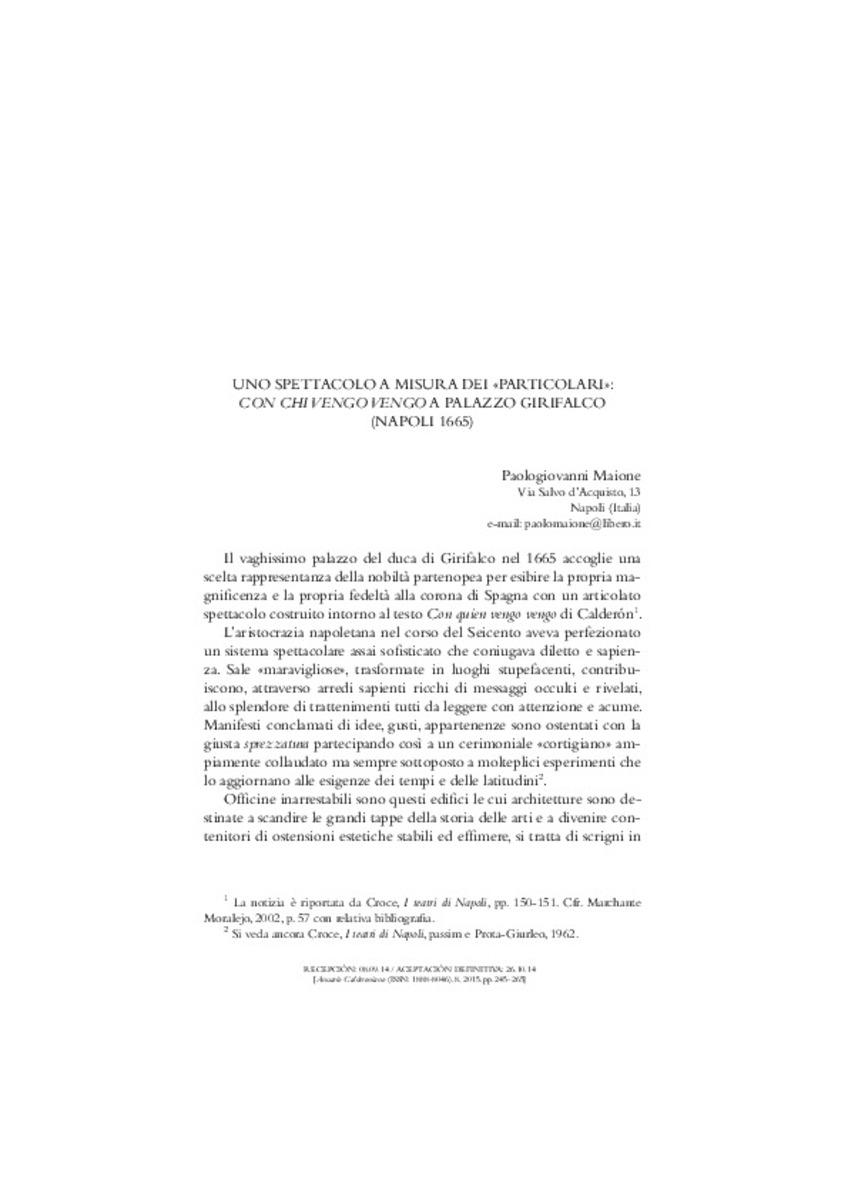Full metadata record
| DC Field | Value | Language |
|---|---|---|
| dc.creator | Maione, P. (Paologiovanni) | - |
| dc.date.accessioned | 2017-02-13T10:57:14Z | - |
| dc.date.available | 2017-02-13T10:57:14Z | - |
| dc.date.issued | 2015 | - |
| dc.identifier.citation | Maione, Paologiovanni, «Uno spettacolo a misura dei “particolari”: “Con chi vengo vengo” a palazzo Girifalco (Napoli 1665)», Anuario Calderoniano, 8, 2015, pp. 245-265. | es_ES |
| dc.identifier.issn | 1888-8046 | - |
| dc.identifier.uri | https://hdl.handle.net/10171/42988 | - |
| dc.description.abstract | En el año 1665 el palacio del duque de Girifalco acoge a unos nobles napolitanos seleccionados para exhibir su magnificencia y su lealtad a la corona de España con un espectáculo muy rico sobre la obra de Calderón “Con quien vengo vengo”. Esta ocasión atestigua el mito de Calderón en Nápoles a lo largo del siglo XVII y las técnicas representativas en las casas aristocráticas. El texto fue puesto en escena utilizando las estrategias típicas del teatro napoletano, con prólogos y «licenze» musicales, bailes entre los actos e idiomas múltiples, y entregado a una compañía de valientes diletantes y profesionales talentosos. Entre «mensajes» performativos y otros se celebra una liturgia de propaganda, en la que se encuentran todos los elementos que amplifican y subrayan el homenaje del duque y de sus huéspedes, que se reconocen en él, al poder español. El esplendor y el mito de la «cattolicissima» ciudad se constituye a través de ocasiones parecidas, que unen los lenguajes más diferentes y la experimentación más atrevida. En este tiempo Nápoles anda perfeccionando y definiendo un papel artístico que en unas décadas se convertirá en una primacía absoluta en toda Europa. | es_ES |
| dc.description.abstract | In 1665 the palace of the Duke of Girifalco hosts a selected group of aristocratic people for a rich performance inspired to Calderón’s “Con quien vengo vengo”, in order to show the magnificence of the house as well as its loyalty to the Spanish king. This event testifies both to the myth of Calderón in Naples in the 17th century and to the performing strategies in private houses. The text was staged using typical resources of Neapolitan theatres, such as prologues, musical insertions, dances between the acts and multiple language scenes, and was entrusted to a troupe formed by talented amateurs and skilled practitioners. Technical solutions and other «messages» constitute a propagandistic «liturgy» aimed at emphasizing the tribute of the Duke (and of his entourage) to the Spanish power. The glamour and the myth of the «catholic» nation is based also upon such events, where different «languages» and bold experiments are combined. At that time Naples is gaining (and bringing to perfection) an artistic role, which will soon turn into an absolute primacy in Europe. | es_ES |
| dc.language.iso | ita | es_ES |
| dc.publisher | Iberoamericana/Vervuert | es_ES |
| dc.rights | info:eu-repo/semantics/openAccess | es_ES |
| dc.subject | Materias Investigacion::Filología y Literatura | es_ES |
| dc.subject | Calderón | es_ES |
| dc.subject | Nápoles | es_ES |
| dc.subject | Girifalco siglo XVII | es_ES |
| dc.subject | Naples | es_ES |
| dc.subject | Girifalco | es_ES |
| dc.subject | 17th Century | es_ES |
| dc.title | Uno spettacolo a misura dei “particolari”: “Con chi vengo vengo” a palazzo Girifalco (Napoli 1665) | es_ES |
| dc.type | info:eu-repo/semantics/article | es_ES |
Files in This Item:
Statistics and impact
Items in Dadun are protected by copyright, with all rights reserved, unless otherwise indicated.






